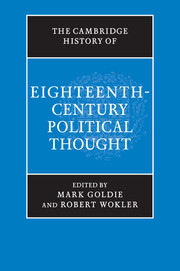Book contents
- Frontmatter
- Introduction
- Part I The ancien régime and its critics
- 1 The spirit of nations
- 2 The English system of liberty
- 3 Scepticism, priestcraft, and toleration
- 4 Piety and politics in the century of lights
- Part II The new light of reason
- Part III Natural jurisprudence and the science of legislation
- Part IV Commerce, luxury, and political economy
- Part V The promotion of public happiness
- Part VI The Enlightenment and revolution
- Biographies
- Bibliography
- Index
4 - Piety and politics in the century of lights
from Part I - The ancien régime and its critics
Published online by Cambridge University Press: 28 March 2008
- Frontmatter
- Introduction
- Part I The ancien régime and its critics
- 1 The spirit of nations
- 2 The English system of liberty
- 3 Scepticism, priestcraft, and toleration
- 4 Piety and politics in the century of lights
- Part II The new light of reason
- Part III Natural jurisprudence and the science of legislation
- Part IV Commerce, luxury, and political economy
- Part V The promotion of public happiness
- Part VI The Enlightenment and revolution
- Biographies
- Bibliography
- Index
Summary
An older historiography of the Enlightenment took the defence or rejection of Christian belief as its starting point and, dividing the world into ‘believers’ and ‘unbelievers’, regarded political thought as derivative of these groupings. Unbelief unleashed a ‘liberal’ assault on monarchy and social hierarchy, while belief came to the defence of these institutions, resulting in ‘conservative’ political thought (see, for example, Martin 1962). This model does justice to something that was incontestably new in the eighteenth century: namely, the emergence of emancipated, secular thought. Yet it is not without its limitations, chief among them being its underestimation of the ‘enlightenment’ of, and dissent within, ‘believing’ communities. Accordingly, this chapter explores the political ramifications of the divisions between ‘orthodox’ and ‘heterodox’ within eighteenth-century Europe’s believing communities. It asks to what extent the religious and theological differences separating Jesuits from Jansenists, orthodox Lutherans or Calvinists from Pietists, and High Church Anglicans from English Dissenters took the form of differing political visions, not only about the church but also about state and society. In so doing, it broaches the relationship between divergent religious sensibilities and differing kinds of political thought. The heart of the most ‘irreligious’ of Europe’s Enlightenments, France, should provide the acid test of any religiously oriented construal of eighteenth-century political thought. France, therefore, must be this European grand tour’s first and longest stop.
- Type
- Chapter
- Information
- The Cambridge History of Eighteenth-Century Political Thought , pp. 110 - 144Publisher: Cambridge University PressPrint publication year: 2006
- 1
- Cited by

